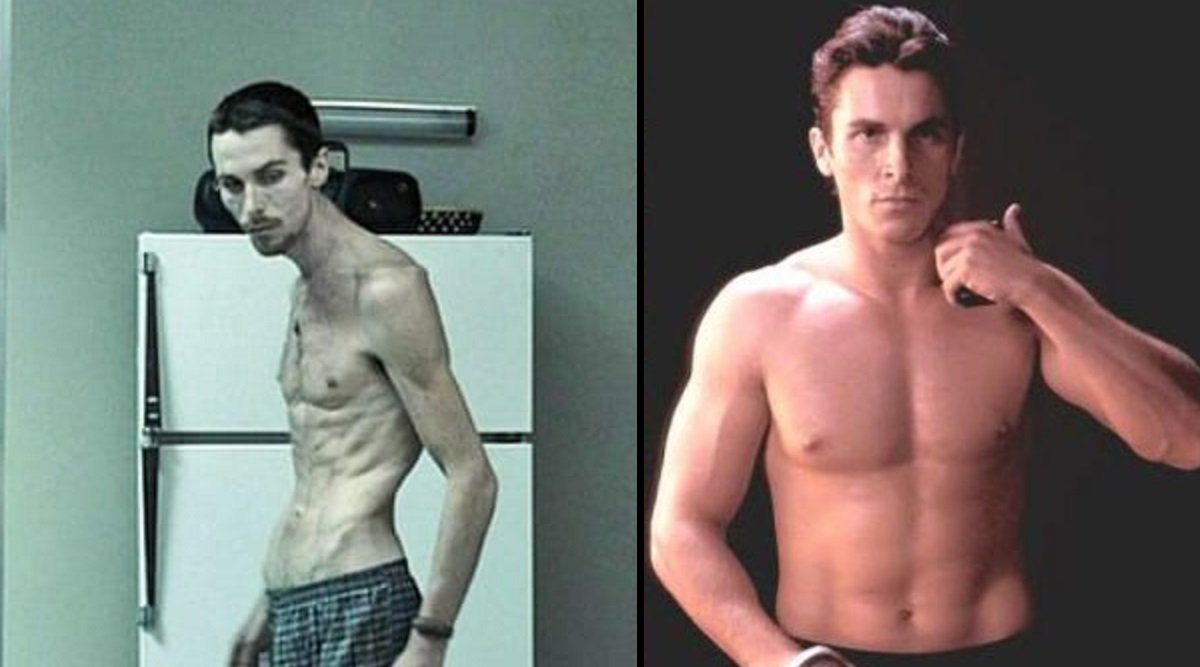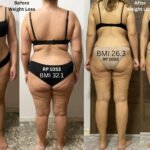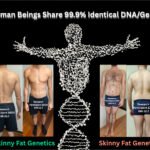Is Muscle/Mass Genetic and How Does It Affect Skinny Fat?
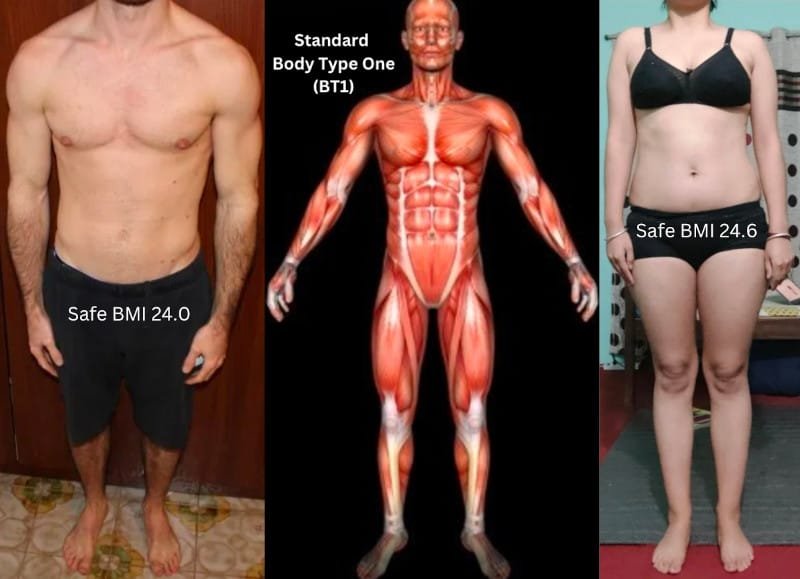
Is muscle/mass genetic? Genetics are the foundation of the human body and muscle/mass tissue is highly heritable (1, 2). Some people are genetically blessed with fully developed muscle/mass, as per the Standard Body Type One (BT1)(3, 4). Others, not so much.
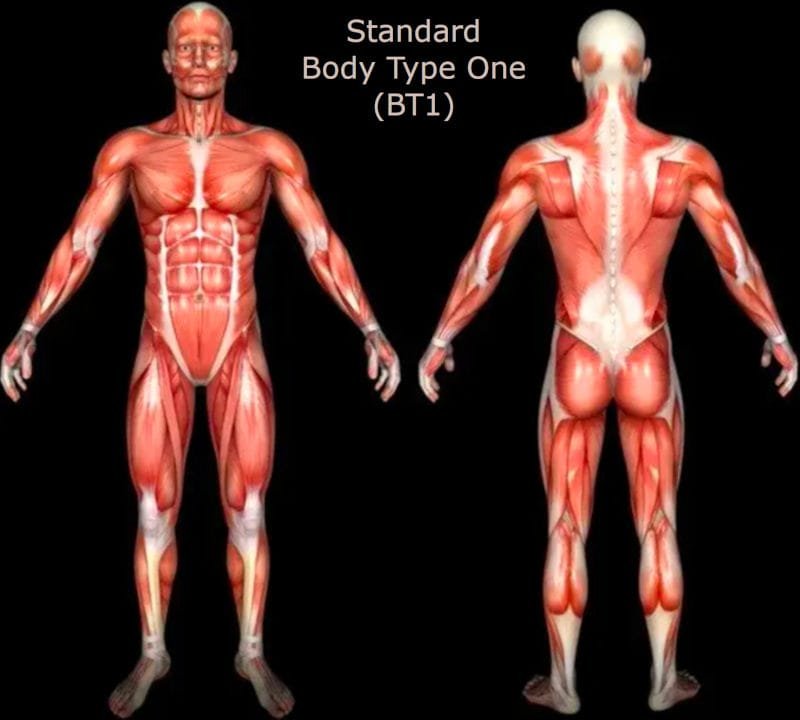 Technically, there are two types of muscle fibers (5, 6, 7, 8, 9); slow twitch (Type I) and fast twitch (Type II, A & B). Type I slow twitch muscle fibers, AKA red fibers because they contain more blood-carrying myoglobin, can provide their own source of energy and sustain basic force for an extended time while being resistant to fatigue. For instance, the muscles responsible for maintaining posture have a higher density of slow-twitch fibers. More aerobically efficient, these fibers are particularly receptive to muscular endurance (toning).
Technically, there are two types of muscle fibers (5, 6, 7, 8, 9); slow twitch (Type I) and fast twitch (Type II, A & B). Type I slow twitch muscle fibers, AKA red fibers because they contain more blood-carrying myoglobin, can provide their own source of energy and sustain basic force for an extended time while being resistant to fatigue. For instance, the muscles responsible for maintaining posture have a higher density of slow-twitch fibers. More aerobically efficient, these fibers are particularly receptive to muscular endurance (toning).
Whereas, Type II fast twitch muscle fibers, AKA white fibers because they do not contain much blood, are defined by two variations. Type IIA fibers are fast oxidative glycolytic, use oxygen to help convert glycogen to ATP, and are relatively resistant to fatigue. Type IIB fibers are fast glycolytic, rely on ATP stored in the muscle cell to generate energy, and fatigue rapidly. Fast-twitch muscle fibers are more suited for strength, power, and explosive performance.
Is Muscle/Mass Genetic and How Does It Affect Skinny Fat?
The total number of default genetic muscle fibers a person has is set at or around birth (10, 11, 12, 13). The rate of muscle growth is by far the greatest in the late stages of pregnancy and in the early postnatal period. At this time, the only reliable ways to accurately know how much genetic default muscle/mass tissue you have are via a Magnetic Resonance Imaging (MRI)(gold standard)(14, 15) scan or computed tomography (CT/CAT)(16, 17) scan, both of which are expensive and uncommon.

The only way to know your Type I and Type II muscle fiber ratio is through an invasive muscle biopsy (18, 9), which is also expensive and uncommon. Although a specific MRI scan may be able to indirectly (55, 56, 57, 61) provide information about muscle fiber composition based on differences in relaxation times, at least, with further theories pending like the myotype (62).
The vast majority of human beings — nearly all — have no idea what their default genetic muscle fiber/tissue/mass measurements are and never have. Their doctors do not know. No one knows. But we do know that many people are born with less muscle. Just as we know genetics play a significant role in how much muscle a person can build (19, 20, 21, 22, 2, 12) — how easy or how hard it is for each person to add muscle mass and maintain it — including the BCL6 gene.
What Happens When a Person is Born with Deficient Genetic Default Muscle/Mass Tissue?
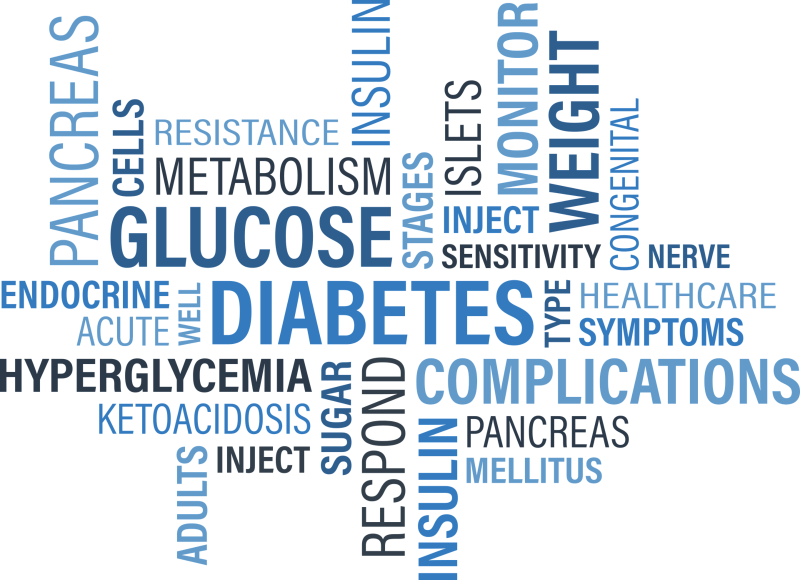 Muscle is a primary insulin-sensitive tissue (63, 64, 65). The less genetic default muscle tissue/more skinny fat a person has, the more it negatively impacts metabolism, particularly glucose uptake, at least. This directly affects insulin, insulin resistance, type-2 diabetes, and being overweight or obese.
Muscle is a primary insulin-sensitive tissue (63, 64, 65). The less genetic default muscle tissue/more skinny fat a person has, the more it negatively impacts metabolism, particularly glucose uptake, at least. This directly affects insulin, insulin resistance, type-2 diabetes, and being overweight or obese.
The more skinny fat tissue — thin fat, cellulite (66) — a person is experiencing, the more sensitive they are to sugar and starch carbs (67) (especially refined and processed carbs common in fast, junk, and processed foods). The more they consume, the more their blood glucose spikes and the more insulin their body requires to process things. Over time, too much can lead to insulin resistance and eventually type-2 diabetes, being overweight, and obesity, no less. The average daily American diet consists of roughly 60% (68, 69, 70, 71) fast, junk, and processed foods loaded with refined sugar and starch carbs.
All of this makes losing, maintaining, and managing regular white/yellow body fat (common adipose tissue) more difficult, which makes reducing skinny fat harder. Not to mention, the more underdeveloped genetic default muscle tissue you have, the more skinny fat tissue you have and the more it negatively affects (58, 59, 60) no less than strength, power, reaction time, speed, balance, coordination, agility, flexibility, endurance, athleticism in general, self-confidence, mental health, overall health, and day-to-day-living.
Research Participant 1170
Research participant 1170 (23)(RP 1170) started their regular fat weight loss within safe/healthy Standard BMI at 24.6 — meaning by scientific/medical BMI definition (24, 25, 26, 27, 28), they have no excess regular fat. This is literally how doctors discern the difference between healthy weight and being overweight or obese.
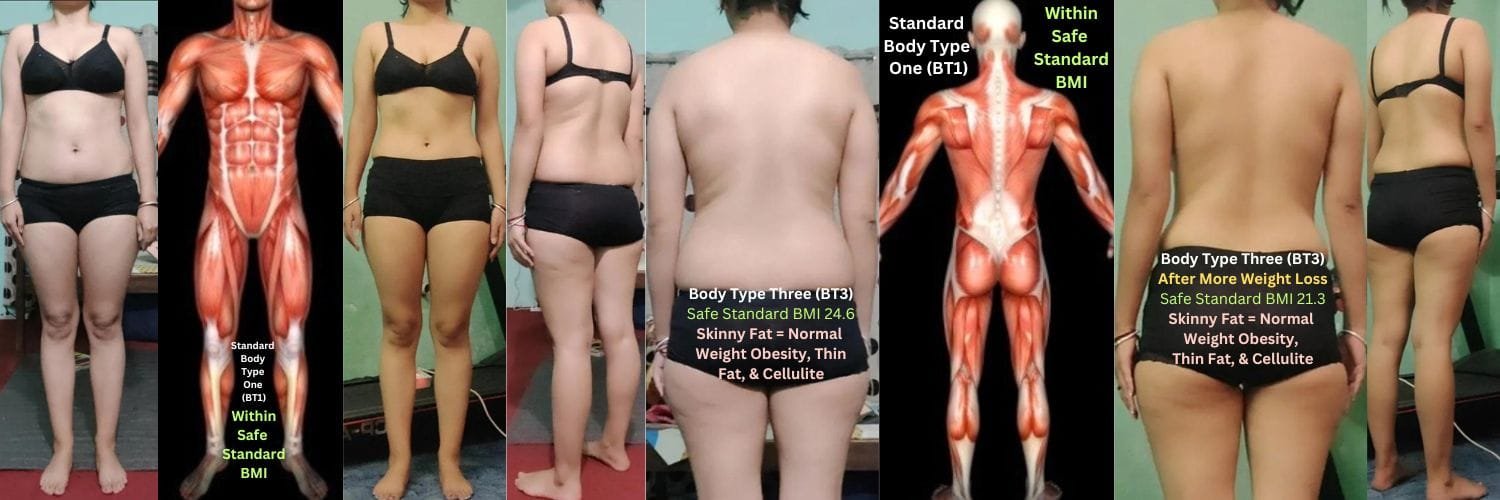
A person cannot have too much regular white/yellow fat and be within safe BMI – it is 100% contrary to and violates the BMI definition. Yes, we know the Standard BMI is inaccurate, but it is the current standard (29, 30) and better than no standard at all. More to the point, just because its accuracy is debatable does not mean it can be contradicted and disregarded.

Skinny Fat Tissue Exists Where Genetic Default Muscle/Mass Should Be, But Is Not
RP 1170 is clearly experiencing normal-weight obesity (66). The excess body fat tissue all over their body — which cannot be and is not regular white/yellow fat (adipose tissue) — is skinny fat tissue in the form of thin fat and cellulite (66). They lost even more regular fat weight down to a BMI of 21.3, yet the genetic default muscle/mass (as per the Standard Body Type One) did not magically appear. The skinny fat tissue is still clearly evident in all the same places it was at BMI 24.6.
In fact, they could lose regular white/yellow fat tissue down to a safe minimum BMI of 18.5, and the genetic default muscle/mass that every Standard Body Type One (BT1) has will not magically appear. This person is not a Standard BT1. They are likely a genetic scientific Body Type Three (BT3)(31), which is defined by how much skinny fat tissue they have relative to vertebrae.
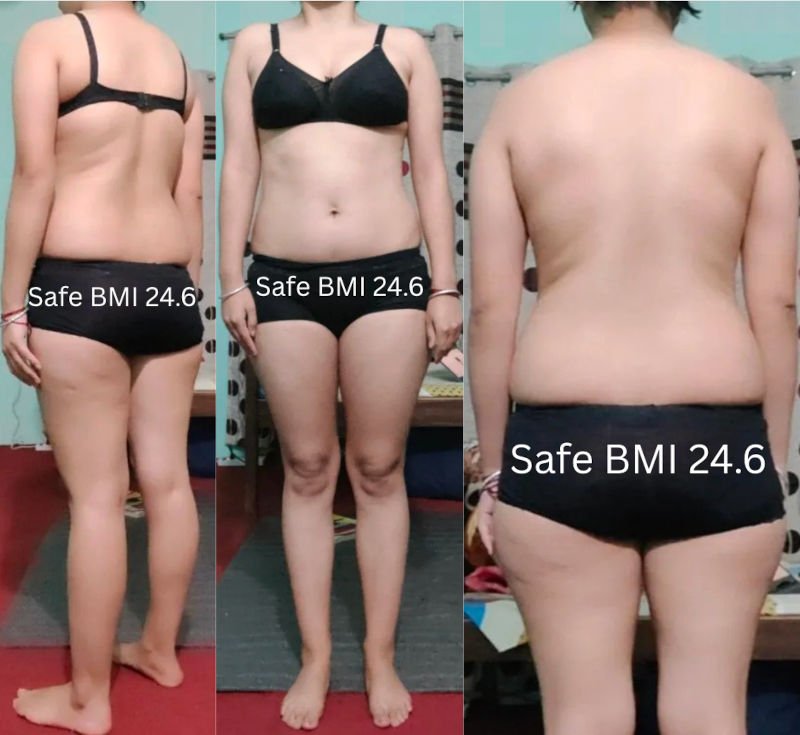
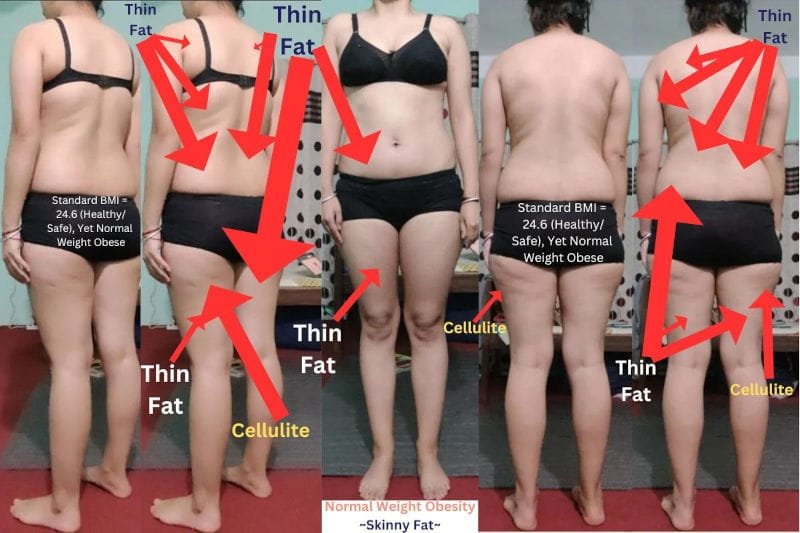
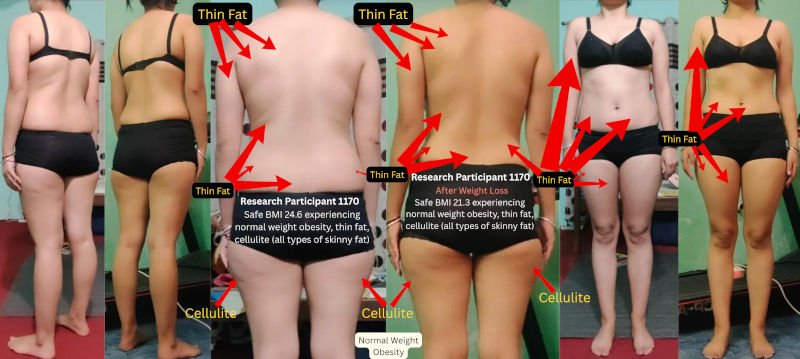
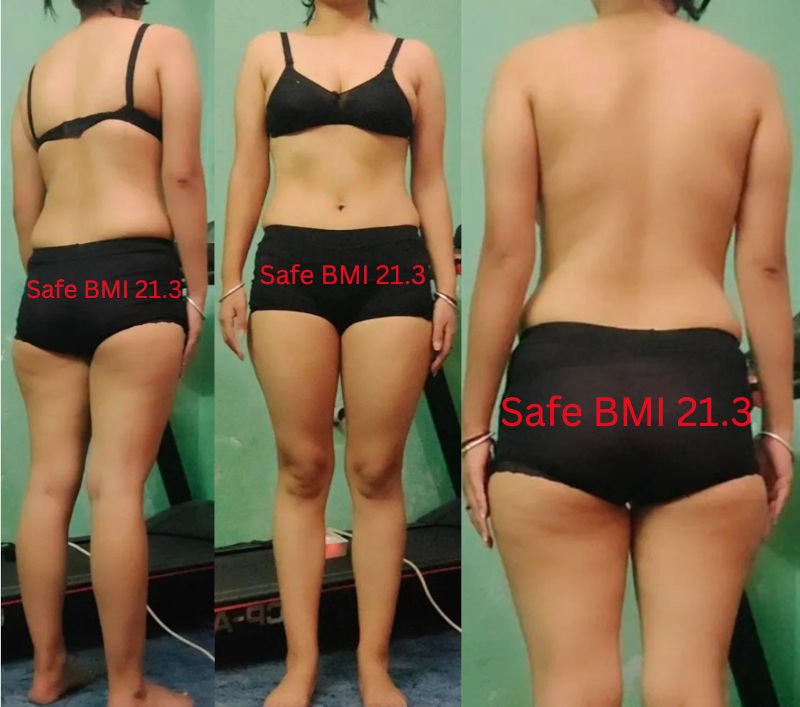
Lost Muscle/Mass Tissue Does Not Become Any Kind Of Fat
Many people claim that RP 1170 just lost muscle mass during weight loss. Now they have regular fat tissue where the muscle tissue was, and have ‘become skinny fat’. But what they are claiming is that muscle tissue turned into fat/skinny fat tissue, which is not possible (32, 33, 34). If that were true, that lost muscle becomes skinny fat, then it would apply equally to 100% all human beings.
Here is Christian Bale when he lost a severe amount of weight for a movie role:
He lost obvious muscle mass, yet he has no indications of any skinny fat tissue. Genetics. Even when he is emaciated the muscle definition is crystal clear. Those people making such claims have no explanation.
Nor can they explain this 22.7 BMI person with obvious skinny fat tissue (thin fat) on his lower back and love handles:
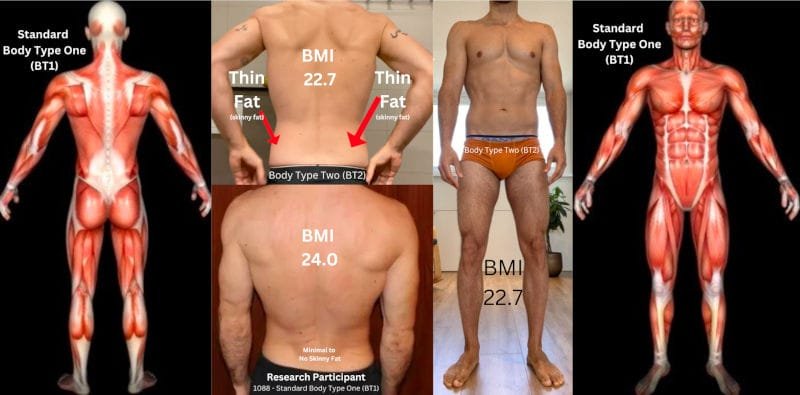

Why did only the muscle on his love handles and lower back turn (impossible)(32, 33, 34) into skinny fat? With no explanation for any of that, the same people will shout, “Stop using genetics as an excuse!” while continuing their outrageous claims by further claiming that with enough hard work in terms of diet and exercise, especially protein and weightlifting, you can turn your skinny fat into muscle (impossible)(32, 33, 34). The best news of all is, thanks to epigenetics, the work you do is permanent.
What Does the Science Say?

Alas, none of that is true (35, 36, 37, 38, 39, 40, 41, 42, 43, 44, 45, 46). Added muscle mass (above and beyond genetic default) due to epigenetic body recomposition (which does temporarily increase muscle fiber size through hypertrophy) changes from exercise and diet, no less, is gradually lost if the exercise that built it ceases consistency and regularity. Epigenetics are not permanent. Muscle cannot turn into fat or vice versa.
Genetics is not an excuse when it comes to no less than default genetic body composition – how much muscle/mass tissue and skinny fat tissue a person has from birth. Genetics is a fact, and our MRI Study (72) will prove it
Although, genetics is, indeed, not an excuse to be unhealthy. The more skinny fat tissue you are experiencing the more diligent you will have to be with healthy, science-based diet, exercise, and lifestyle choices throughout your life to be a healthy weight and remain healthy.
Is Muscle/Mass Genetic – How Does It Affect Skinny Fat?
All that said, with enough hard work you can reduce any skinny fat tissue you have by safely losing regular white/yellow fat weight and adding muscle mass; you may even look like (or close to) the Standard BT1. And with enough hard work consistently and regularly throughout your life, you can maintain those changes. Moreover, maybe, if you are one of the very rare few people who tempt evolution and cause a positive genetic mutation (47, 48, 49, 50) that is permanent, you might pass it on to your next generation progeny.
Yes, muscle/mass (or lack thereof/skinny fat) is genetic while being directly influenced by diet, exercise, and lifestyle. The more skinny fat (lack of genetic muscle tissue)(66) you have, the more it affects your regular white/yellow fat weight loss and weight gain efforts along with metabolism (51), diet (52), exercise (53), and lifestyle (54). The Scientific Health Quizzes help make sense of all of that, free options are available.
References
- NIH, National Library of Medicine: Genetic aspects of skeletal muscle strength and mass with relevance to sarcopenia, April 4, 2012, Stephen M Roth. https://pmc.ncbi.nlm.nih.gov/articles/PMC4816288/
- Nature, Nature Communications: Rare genetic variants impact muscle strength, June 10, 2023, Yunfeng Huang, Dora Bodnar, Chia-Yen Chen, Gabriela Sanchez-Andrade, Mark Sanderson, Biogen Biobank Team, Jun Shi, Katherine G. Meilleur, Matthew E. Hurles, Sebastian S. Gerety, Ellen A. Tsai & Heiko Runz. https://www.nature.com/articles/s41467-023-39247-1
- Britannica: human muscle system, Shane W. Cummings and Robin Huw Crompton (Fact-checked by the Editors of Encyclopaedia Britannica. https://www.britannica.com/science/human-muscle-system
- Taber’s Medical Dictionary: muscle, https://www.tabers.com/tabersonline/view/Tabers-Dictionary/765961/all/muscle
- Ace Fitness: Muscle Fiber Types: Fast-Twitch vs. Slow-Twitch, October 30, 2015, Pete McCall. https://www.acefitness.org/resources/pros/expert-articles/5714/muscle-fiber-types-fast-twitch-vs-slow-twitch/
- NIH, National Library of Medicine: Muscle fiber types, May 1982, G J Herbison, M M Jaweed, and J F Ditunno. https://pubmed.ncbi.nlm.nih.gov/6462127/
- Oxford Academic, Physical Therapy and Rehabilitation Journal (PTJ): Human Skeletal Muscle Fiber Type Classifications, November 1, 2001, W Scott, PT, MPT, J Stevens, PT, MPT, and SA Binder-Macleod, PT, PhD. https://academic.oup.com/ptj/article-abstract/81/11/1810/2857618?redirectedFrom=fulltext
- Wikipedia: Skeletal muscle. https://en.wikipedia.org/wiki/Skeletal_muscle
- NASM: Fast-Twitch Vs. Slow-Twitch Muscle Fiber Types + Training Tips, Nicole Golden. https://blog.nasm.org/fitness/understanding-fast-twitch-vs-slow-twitch-mucle-fibers
- ScienceDirect, Muscle Growth: Muscle Structure and Function, 2017, C.-n. (Joyce) Chen PT, PhD and L.A. Snow MD, PhD in Orthopaedic Physical Therapy Secrets (Third Edition). https://www.sciencedirect.com/topics/biochemistry-genetics-and-molecular-biology/muscle-growth
- NIH, National Library of Medicine: Muscle Cell Growth and Development, Ronald E. Allen. https://www.ncbi.nlm.nih.gov/books/NBK218163/
- NIH, National Library of Medicine: Genesis, Modulation, and Regeneration of Skeletal Muscle, 2002, Bruce Alberts, Alexander Johnson, Julian Lewis, Martin Raff, Keith Roberts, and Peter Walter. https://www.ncbi.nlm.nih.gov/books/NBK26853/
- NIH, National Library of Medicine: Not all the number of skeletal muscle fibers is determined prenatally, Mingsen Li, Xingyu Zhou, Yaosheng Chen, Yaping Nie, Huaxing Huang, Hu Chen, and Delin Mo. https://pmc.ncbi.nlm.nih.gov/articles/PMC4642764/
- Livestrong: How to Measure Your Muscle Mass, September 27, 2021, Amy Marturana Winderl, CPT (Reviewed byK. Aleisha Fetters, CSCS). https://www.livestrong.com/article/501467-how-to-calculate-muscle-mass-percentage/
- MedicalNewsToday: How and why to calculate muscle mass percentage, September 2, 2024, Aaron Kandola Ph.D, M.Sc. (Medically reviewed by Megan Soliman, MD). https://www.medicalnewstoday.com/articles/muscle-mass-percentage
- NIH, National Institute of Biomedical Imaging and Bioengineering: Computed Tomography (CT), https://www.nibib.nih.gov/science-education/science-topics/computed-tomography-ct
- Mayo Clinic: CT scan. https://www.mayoclinic.org/tests-procedures/ct-scan/about/pac-20393675
- NIH, National Library of Medicine: Prediction of muscle fiber composition using multiple repetition testing, October 22, 2020, Elliott CR Hall, Evgeny A Lysenko, Ekaterina A Semenova, Oleg V Borisov, Oleg N Andryushchenko, Liliya B Andryushchenko, Tatiana F Vepkhvadze, Egor M Lednev, Piotr Zmijewski, Daniil V Popov, Edward V Generozov, and Ildus I Ahmetov. https://pmc.ncbi.nlm.nih.gov/articles/PMC8139349/
- Northwestern Now: Gene’s role in attaining and maintaining muscle mass revealed, February 13, 2024, Win Reynolds. https://news.northwestern.edu/stories/2024/02/bcl6-gene-role-in-muscle-revealed/
- NIH, National Library of Medicine: Genetic influences on muscle strength, lean body mass, and bone mineral density: a twin study, December 1997, N K Arden and T D Spector. https://pubmed.ncbi.nlm.nih.gov/9421240/
- NIH, National Library of Medicine: Transcriptional programming of translation by BCL6 controls skeletal muscle proteostasis, February 6, 2024, Krithika Ramachandran, Christopher R Futtner, Meredith A Sommars, Mattia Quattrocelli, Yasuhiro Omura , Ellen Fruzyna 1 , Janice C Wang, Nathan J Waldeck , Madhavi D Senagolage, Carmen G Telles , Alexis R Demonbreun , Erin Prendergast , Nicola Lai 7 , Daniel Arango , Ilya R Bederman , Elizabeth M McNally, and Grant D Barish. https://pubmed.ncbi.nlm.nih.gov/38337096/
- MedlinePlus: Myostatin-related muscle hypertrophy. https://medlineplus.gov/genetics/condition/myostatin-related-muscle-hypertrophy/
- Fellow One Research: Body Type Test (Quiz) Results 1170 – Body Type Three (BT3) Female (Woman), Generation Z. https://www.fellowone.com/fellow-one-research/the-four-body-types/body-type-quiz/body-type-test-quiz-results-1170-body-type-three-bt3-female-woman-generation-z/
- Cleveland Clinic: Brown Fat, September 2, 2022, https://my.clevelandclinic.org/health/body/24015-brown-fat
- NIH, National Library of Medicine: Physiology, Body Mass Index, November 5, 2023, Asia Zierle-Ghosh and Arif Jan. https://www.ncbi.nlm.nih.gov/books/NBK535456/
- ScienceDirect: Adipose tissue and insulin resistance in obese, Volume 137, May 2021, Bulbul Ahmed, Rifat Sultana, and Michael W. Greene. https://www.sciencedirect.com/science/article/pii/S0753332221001001
- NIH, National Library of Medicine: Obesity, Adipose Tissue and Vascular Dysfunction, April 2, 2022, Mascha Koenen, Michael A Hill, Paul Cohen, and James R Sowers. https://pmc.ncbi.nlm.nih.gov/articles/PMC8026272/
- Cleveland Clinic: Obesity, September 10, 2024. https://my.clevelandclinic.org/health/diseases/11209-weight-control-and-obesity
- Wikipedia: Body mass index, https://en.wikipedia.org/wiki/Body_mass_index
- The New York Times: U.S. to Widen Its Definition Of Who Is Fat, June 04, 1998, The Associated Press. https://www.nytimes.com/1998/06/04/us/us-to-widen-its-definition-of-who-is-fat.html
- Fellow One Research: Body Type Science Research Data. https://www.fellowone.com/category/fellow-one-research/the-four-body-types/body-type-science/body-type-quiz/research-data/
- Healthline: Does Fat Turn into Muscle? What to Know, March 2, 2021, Katey Davidson, MScFN, RD, CPT (Medically reviewed by Jake Tipane, CPT). https://www.healthline.com/nutrition/does-fat-turn-into-muscle
- The New York Times: The Claim: Muscle Turns to Fat When You Stop Working Out, July 26, 2006, Anahad O’Connor. https://www.nytimes.com/2005/07/26/health/nutrition/the-claim-muscle-turns-to-fat-when-you-stop-working-out.html
- NIH, National Library of Medicine: Muscle-to-fat interaction: a two-way street?, January 1, 2010, Bente K Pedersen. https://pmc.ncbi.nlm.nih.gov/articles/PMC2821541/
- Wikipedia: Epigenetics. https://en.wikipedia.org/wiki/Epigenetics
- Nature: Epigenetics: Reversible tags, June 26, 2013. Jessica Wright. https://www.nature.com/articles/498S10a
- Centers for Disease Control and Prevention: Epigenetics, Health, and Disease, May 15, 2024. https://www.cdc.gov/genomics-and-health/about/epigenetic-impacts-on-health.html
- MedlinePlus: What is epigenetics? https://medlineplus.gov/genetics/understanding/howgeneswork/epigenome/
- NIH, National Library of Medicine: Epigenetics: The Science of Change, March 2006, Bob Weinhold. https://www.ncbi.nlm.nih.gov/pmc/articles/PMC1392256/
- National Human Genome Research Institute: Epigenetics, October 8, 2024. Belen Hurle, Ph.D. Former Associate Investigator Division of Intramural Research. https://www.genome.gov/genetics-glossary/Epigenetics
- UC Berkeley, Retirement Center: Muscle Mass Can Decline 25% In As Little As 2 Weeks … But We Can Get It Back!, July 2022, Cary Sweeney. https://retirement.berkeley.edu/publications/muscle-mass-can-decline-25-little-2-weeks-we-can-get-it-back
- Global News: If you stop exercising, here’s how quickly you’ll lose strength, July 20, 2019, Laura Hensley. https://globalnews.ca/news/5653575/how-long-does-it-take-to-lose-muscle-mass/
- Shape: How Long Does It Take to Lose Muscle?, July 28, 2022, Megan Falk. https://www.shape.com/fitness/workouts/strength-training/how-long-does-it-take-to-lose-muscle
- NIH, National Library of Medicine: Substantial skeletal muscle loss occurs during only 5 days of disuse, March 2014, B T Wall, M L Dirks, T Snijders, J M G Senden, J Dolmans, and L J C van Loon. https://pubmed.ncbi.nlm.nih.gov/24168489/
- MVPT Physical Therapy: How Long It Takes to Build and Lose Muscle, https://mvpt-physicaltherapy.com/how-long-it-takes-to-build-and-lose-muscle/
- Harvard Health Publishing: Don’t let muscle mass go to waste, April 10, 2023, Matthew Solan (Reviewed by Howard E. LeWine, MD, Chief Medical Editor). https://www.health.harvard.edu/staying-healthy/dont-let-muscle-mass-go-to-waste
- Skinny Fat Science: How To Fix Skinny Fat, July 27, 2024. https://skinnyfat.fellowone.com/how-to-fix-skinny-fat/
- MedlinePlus: What is a gene variant and how do variants occur? https://medlineplus.gov/genetics/understanding/mutationsanddisorders/genemutation/
- Cleveland Clinic: Genetic Mutations in Humans, May 24, 2022. https://my.clevelandclinic.org/health/body/23095-genetic-mutations-in-humans
- NIH, National Library of Medicine: The Maintenance of DNA Sequences, https://www.ncbi.nlm.nih.gov/books/NBK26881/
- Skinny Fat Science: How Skinny Fat Affects Metabolism, August 7, 2024. https://skinnyfat.fellowone.com/how-skinny-fat-affects-metabolism/
- Skinny Fat Science: The Best Skinny Fat Diet, According to Science, July 29, 2024. https://skinnyfat.fellowone.com/the-best-skinny-fat-diet-according-to-science/
- Skinny Fat Science: The Best Skinny Fat Exercise, According to Science, August 2, 2024. https://skinnyfat.fellowone.com/the-best-skinny-fat-exercise-according-to-science/
- Skinny Fat Science: The Best Skinny Fat Lifestyle, According to Science, August 14, 2024. https://skinnyfat.fellowone.com/the-best-skinny-fat-lifestyle-according-to-science/
- NIH, National Library of Medicine: Noninvasive technique to evaluate the muscle fiber characteristics using q-space imaging, April 4, 2019, Junichi Hata, Daisuke Nakashima, Osahiko Tsuji, Kanehiro Fujiyoshi, Kaori Yasutake, Yasushi Sera, Yuji Komaki, Keigo Hikishima, Takeo Nagura, Morio Matsumoto, Hideyuki Okano, and Masaya Nakamura. https://pmc.ncbi.nlm.nih.gov/articles/PMC6449066/
- NIH, National Library of Medicine: MRI in the assessment of adipose tissues and muscle composition: how to use it, August 2020, Florian Alexander Huber, Filippo Del Grande, Stefania Rizzo, Giuseppe Guglielmi, and Roman Guggenberger. https://pmc.ncbi.nlm.nih.gov/articles/PMC7378099/
- NIH, National Library of Medicine: Skeletal Muscle DT-MRI Fiber Tracking: Rationale, Data Acquisition and Analysis Methods, Applications, and Future Directions, March 1, 2018, Bruce M Damon, Martijn Froeling, Amanda K W Buck, Jos Oudeman, Zhaohua Ding, Aart J Nederveen, Emily C Bush, and Gustav J Strijkers. https://pmc.ncbi.nlm.nih.gov/articles/PMC5136336/
- NIH, National Library of Medicine: The Importance of Muscular Strength in Athletic Performance, October 2016, Timothy J Suchome, Sophia Nimphius , and Michael H Stone. https://pubmed.ncbi.nlm.nih.gov/26838985/
- Physiopedia: Physical Fitness and Its Components. https://www.physio-pedia.com/Physical_Fitness_and_Its_Components
- Verywell Fit: 6 Skill-Related Fitness Components to Improve Athletic Performance, May 10, 2024, Laura Williams, MSEd, ASCM-CEP (Reviewed by Tara Laferrara, CPT). https://www.verywellfit.com/skill-related-fitness-components-4155209
- NIH, National Library of Medicine: A new method for non-invasive estimation of human muscle fiber type composition, July 7, 2011, Audrey Baguet, Inge Everaert, Peter Hespel, Mirko Petrovic, Eric Achten, and Wim Derave. https://pubmed.ncbi.nlm.nih.gov/21760934/
- Muscle Talent Scan: A non-invasive technique to estimate muscle fiber type distribution. https://muscletalentscan.com/
- ScienceDirect, Cell Metabolism: The many actions of insulin in skeletal muscle, the paramount tissue determining glycemia, April 6, 2021, Volume 33, Issue 4, Pages 758-780, Lykke Sylow, Victoria, Tokarz, Erik A. Richter, and Amira Klip. https://www.sciencedirect.com/science/article/pii/S1550413121001273
- NIH, National Library of Medicine: Role of Skeletal Muscle in Insulin Resistance and Glucose Uptake, April 26, 2021, Karla E Merz and Debbie C Thurmond. https://pmc.ncbi.nlm.nih.gov/articles/PMC8074531/
- NIH, National Library of Medicine: Obesity and insulin resistance, April 15, 2000, Barbara B Kahn and Jeffrey S Flier. https://pmc.ncbi.nlm.nih.gov/articles/PMC380258/
- Skinny Fat Science: What Is Skinny Fat?, July 26, 2024. https://skinnyfat.fellowone.com/skinny-fat-science/what-is-skinny-fat/
- Skinny Fat Science: The Best Skinny Fat Diet, According to Science, July 29, 2024. https://skinnyfat.fellowone.com/skinny-fat-science/the-best-skinny-fat-diet-according-to-science/
- The Guardian: Ultra-processed US foods are ultra-bad for you. Here’s what to know, May 20, 2024, Cecilia Nowell. https://www.theguardian.com/environment/article/2024/may/20/processed-foods-health-what-to-know
- NIH, National Library of Medicine: Characterizing Ultra-Processed Foods by Energy Density, Nutrient Density, and Cost, May 28, 2019, Shilpi Gupta, Terry Hawk, Anju Aggarwal, and Adam Drewnowski. https://pubmed.ncbi.nlm.nih.gov/31231655/
- CDC: Changes in Serving Size, Calories, and Sodium Content in Processed Foods From 2009 to 2015, March 15, 2018, Volume 15 (Original Research), Jenifer E. Clapp, MPA, Sarah A. Niederman, MPH, Elizabeth Leonard, MPH, and Christine J. Curtis, MBA. https://www.cdc.gov/pcd/issues/2018/17_0265.htm
- Henry Ford Health: Ultra-Processed Foods Are Sabotaging Your Diet. Here’s How To Cut Them Out, September 29, 2023, Henry Ford Health Staff. https://www.henryford.com/blog/2023/09/ultra-processed-foods
- Skinny Fat Science: Scientific Skinny Fat MRI Study – Proving What Skinny Fat Is, March 26, 2025. https://skinnyfat.fellowone.com/skinny-fat-science/scientific-skinny-fat-mri-study-proving-what-skinny-fat-is/

